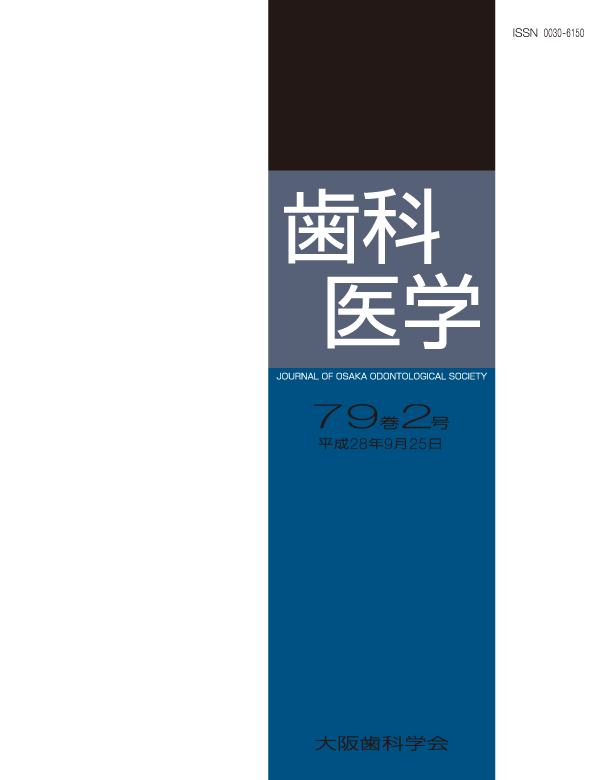All issues

Volume 79, Issue 1
Displaying 1-3 of 3 articles from this issue
- |<
- <
- 1
- >
- >|
-
Masahiro Nakajima, Akihiro Nakajima, Yuichi Shoju, Kenta Ozaki, Suguru ...Article type: Article
2016 Volume 79 Issue 1 Pages 1-9
Published: March 25, 2016
Released on J-STAGE: June 15, 2017
JOURNAL FREE ACCESSSagittal split ramus osteotomy is the most common orthognathic surgery, and is most often used for the treatment of jaw deformity. The miniplate is usually used after osteotomy to shorten the intermaxillary fixation period and avoid relapse. We investigated the optimal fixation method. Time-dependent stress analysis was performed using three-dimensional finite element analysis to investigate stress changes on the mandible and bone fixation plate during fixation using two titanium miniplates. Models were fabricated at 1, 3, 6 and 12 months after sagittal split ramus osteotomy. Occlusal and mouth-closing muscle forces were added to the model to investigate the equivalent stress change on the proximal bone segment, distal bone segment, bone junction area, and bone fixation plate. Equivalent stress changes increased on the proximal and distal bone segments postoperatively from 1 to 12 months. Stress concentration was observed in the frontal margin of the mandibular ramus during each period. Although equivalent stress on the bone junction area increased from 1 to 6 months postoperatively, it decreased at 12 months. Although the highest stress was observed on the bone fixation plate at 1 month, stress dispersion was observed in the proximal and distal bone segments, osteosynthesis area, and fixation plate compared with fixation using one titanium miniplate. We found that fixation using 2 titanium miniplates avoids high stress concentration in certain areas, and allows stress distribution compared with fixation using one titanium miniplate. Therefore, it eliminates the need for postoperative intermaxillary fixation with wires and avoids relapse.View full abstractDownload PDF (18822K) -
Suguru Dateoka, Hiroki Omoto, Masahiko Kanazumi, Masahiro NakajimaArticle type: Article
2016 Volume 79 Issue 1 Pages 10-16
Published: March 25, 2016
Released on J-STAGE: June 15, 2017
JOURNAL FREE ACCESSIn April 2014, our hospital established a new independent "Department of Dentistry for Disability and Oral Health". We conducted an anonymous questionnaire survey of dental treatments administered to patients with disabilities in one city, a relatively large number of whom had been referred to our hospital, targeting the general dental practitioners registered in the prefectural dental association of that city. We obtained 574 responses from 2046 respondents, representing a recovery rate of 28.1%. The mean age was 55 years, and the mean time in practice was 22 years. About half of the respondents worked in dental clinics in existing buildings with other tenants making it difficult to construct a new clinic with universal design and accessibility for individuals with disabilities.
Although about 70% of the dental clinics provided treatment to patients with various degrees of disability, 80% of treated less than 10 patients with disabilities per year. A high percentage of consultations were conducted by attending physicians and most dental treatments administered were based on systemic management. For dysphagia, 90% of the respondents reported that oral function training was required to improve quality of life, but more than 30% had difficulty implementing oral functional training.
There is a need for dental treatment not only for occlusal functional recovery but also for oral functional recovery, including swallowing training. In addition, our hospital, which is a tertiary care institution, is expected to accept patients with severe disabilities and establish a human resource development department that can respond well to patients with disabilities. Also, attention should be given to dental treatment for patients with disabilities, the acceptance of such patients, and training of the staff in caring for them. Efforts should be made to grasp the needs of the community, to perform proactive medical care, and to provide the most up-to-date information for general dental practitioners, patients, and welfare facilities, as well as to strive to educate medical professionals.View full abstractDownload PDF (928K) -
Shusuke Nakagawa, Takahisa Okawa, Yuki Ito, Takahiro Fukumoto, Hoda Wu ...Article type: Article
2016 Volume 79 Issue 1 Pages 17-22
Published: March 25, 2016
Released on J-STAGE: June 15, 2017
JOURNAL FREE ACCESSWe evaluated use of the AR Navigation System for preparation of the facings of hard-resin abutment teeth. We also conducted a questionnaire survey among participants regarding their impressions about the use of the AR system. The participants were 12 fifth-year students at Osaka Dental University. Their assigned task was fabrication of the facings of hard-resin crown for a maxillary left central incisor abutment tooth. The three categories of students were those with (A) no prior training with a training manual, (B) prior training only with a training manual, (C) prior training with a training manual and use of the training manual during fabrication, and (D) prior training with a training manual and use of AR during fabrication. After the task was fully completed, we evaluated the amount of abutment tooth removed and the impression the students had of the use of the AR system. The results suggest that the AR Navigation System is useful for controlling the amount of the facing removed during fabrication of hard-resin abutment teeth.View full abstractDownload PDF (9368K)
- |<
- <
- 1
- >
- >|